Art and Storytelling
Notes on N-fusion Study #2
By Paul McLean
Background and Contextual Overview
The impetus for this essay is an inquiry by the purchaser of the painting, my childhood buddy John Price. We are both older gentleman, now. His life course did not veer through the art world. As we refreshed our friendship through a social media DM thread, John expressed interest in N-fusion. Not unexpectedly, he asked for more information on the artwork, along the lines of “What is it about?” Or, “What is the inspiration for it?” Or, “What is the thinking behind it?” in other words, “What is its concept?’ (Specifically, John asked, “…what inspired this piece?”)
I have made many paintings, and sold quite a lot of them over the years. Earlier in my career, I worked as a sales representative in art galleries, sometimes employed by the owners, sometimes in galleries or art spaces that I owned or directed or both. Very commonly, buyers are curious to know about the artist’s ideas, the circumstances of the art’s coming into existence. To satisfy the collector or potential collector’s curiosity, an artist might share a story or narrative that becomes the context for the art in question. The presenter or dealer will frequently assist in the contextualization process. We know that once a person purchases the art and installs it in their home or office, they will often have the opportunity to share the work with friends, family and acquaintances. The art’s storyline in this way is passed through to others. Art can also serve as a conversation-starter, a social catalyst. Art and its contextual narrative can spark interaction, beyond its visual impact and presence.
For collectible artists, resources are deployed to consolidate the story attached to the artist and art. Writers, critics, art historians, dealers, fellow artists and so on are invited or recruited to construct a bespoke story or narrative, which is made available to any interested in the artist and work. These days, social media and networks serve to disperse and amplify the art in context. Lines of definition are blurring, and it is now a thing that the networked aesthetic and metadata can even be recognized and acknowledged as the art itself. In this scheme, no actual art object is necessary. The context to a degree supplants the object and its embedded content. We have seen virtual art simulacra become sufficient for the purposes of market and discourse, centered in computer and communications device technology. Art comes across to a viewer in the new economy as an aggregate of image and context, combining in a merged field as hybridized content, with speculative potential. Words like “artificial,” “synthetic” and “intelligence” or “machine” are the parlance of those domains. Subject and object co-exist in a compressed thing - both immaterial and material - to which the identifying term “art” is applied. The NFT boom (and bust) tested the viability of provenance overtaking the importance of the art itself. Prompt-generated art has dramatically disrupted established notions of authorship and collaboration, and raised important questions about artistic authenticity, derivation and compensation. With online AI widgets, the text in the form “makes” the art!
A great example of Art and Storytelling!
If the rules of storytelling in relation to art are evolving, or at least changing, a student of the history of talking about art would be, speaking for myself, should be, inclined to admit that the language pertinent to art is and has always been changeable. Thinkers, who are inevitably wordsmiths also, have turned their attention to art, since Plato did so in imagining his Republic. One cannot know, but one can speculate that the earliest expressive use of paint and what we think of as basic art materials (stone, wood, minerals, fabric and so on) had to have been accompanied by storytelling, or some kind of vocal complement. Maybe, chanting, and dancing, percussion — which are the basic elements of ritual, of what we call culture or society. It seems a natural human function, peculiar to our most common, communal arrangements. Basically, people tend to develop ways of living that revolve around storytelling and images rendered concretely. The embellishments are as colorful Nature itself, and as variable as human beings, ourselves. Yet, it is important to recognize that one of art’s unique qualities is its autonomy as an object, accessed through the sense of sight first, then touch, possibly. Pre-contemporary art exists a priori to its interpretation and its nominal definition. Such art can be seen and not heard, can be unspeakable. It can be experienced in silence.
∞
Another wrinkle on contemporary art storytelling practice involves valuation on its own terms. The story becomes the details of art’s quantification over time, and its speculative value. Above I mentioned art sales in relation to art talk. There are definitely levels to that game. At the top of the commercial hierarchy of art, the lingo (i.e., “art-speak”) applied to art is similar to that sort which pertains to many speculative or risky investments or assets. Inflected by academic or institutional formalism, the word-smithing for venture art can be as obscure as legalese or medical terminology. Signature art in art management circles is not uncommonly described as branded, and such art is analyzed on the basis of return-on-investment (ROI). Art in some circles and exchanges is reduced to its numbers, and specific logistical factors that affect availability and acquisition: e.g., location, legal status, current ownership, etc. It is tempting for me to refer to such art as market product, or industrial art, or commercial art, although this last descriptor is confusing due to the historical meaning. Design and graphic art for commercial purposes used to operate in a silo demarcated from fine art. No longer is this necessarily true. The borders are blurry.
What’s hot or not is the grist for the international art fair mill, whose aficionados routinely rely on consultants or other specialist services to determine whether art is worth investing in. In this domain of the art world, spectacle drives the quasi-public coverage, while a preponderance of the actual economic activity unfolds privately. The mechanics of this art exchange remains mostly opaque and highly unregulated, situated as it (the art market) is in the broader international economy of the global-high-net-worth class. There is much more to say about this phenomenon, but I have written and spoken about extensively elsewhere.
Also within the spectrum of contemporary art storytelling, we see art used as a vehicle for movements committed to reforming society. The program of reformations extends to the individual member of society, coming from all directions, through media and social or interpersonal relations. Generally speaking, art and culture are co-opted by movements to facilitate the alteration of perception and imagination, in general and particular. The prospects of such efforts aside, the advocates of art in the service of ideology may be pushing either reactionary or revolutionary visions, although delivery systems may obscure one from the other. The tooling of art follows protocols that by now are centuries old, with roots in Catholicism. Propaganda methods may be refitted for a great range of issues, including product marketing. Propaganda deploys art and artists as specialists with a unique profile for cultivating emotional support for ideologically-based movements, to sell product or expand the reach of the markets, or to rationalize or justify the administration and exercising of power, in its manifold iterations. Presently, art is practically fractal and fungible in its utility to the powerful, and to those who desire power (or inclusion and acceptance in the administration of power). It can be hard to tell for the casual viewer what the art on view is intended to do, or communicate, and who or what might be motivating and cultivating its creation or conception. Art has come to rely on disclosures for necessarily clarification. Unfortunately, given disclosures themselves can be misleading, or obtuse and in need of additional clarifications. The contextual narratives at any stage of dissemination can be the cause of controversy, by intention or accident.
From a series of woodcuts (1545) usually referred to as the Papstspotbilder or Papstspottbilder, by Lucas Cranach, commissioned by Martin Luther. Title: Kissing the Pope's Feet. German peasants respond to a papal bull of Pope Paul III. Caption reads: "Don't frighten us Pope, with your ban, and don't be such a furious man. Otherwise we shall turn around and show you our rears". (Wikipedia)
In the midst of great technological change and historic shifts in the distribution of global power and information, identity has emerged as a focal point of tension. This is especially true post-Freud, in the 20th and 21st centuries. The faceting of self is accelerated by the virtualization of post-industrial, post-colonial — post-contemporary — existence. Adding to the dimensional stresses on Self is a burgeoning planetary awareness of challenging environmental conditions, and the prevalence of crisis and catastrophe due in part to climate change. The digital, virtual faceting of identity is ubiquitous for a large portion of the global population, i.e., those connected via social media and mobile communication networks. The rest of the population is increasingly rendered by powerful, authoritarian forces into euphemistic categories of exclusion, relegated to sub-class status, e.g., “nonessential,” as we saw during the pandemic. People(s) are involuntarily registered or identified by empowered entities and individuals and demographics groups as “precarious,” “unfortunates,” “deplorables,” or even “expendable,” in extreme cases. Art in this scenario becomes a tool of mediation, justification and rationalization, utilized by actors, agents and operators committed to polar sectionalizing of populations, to turning one side or person against an other, or staking claim to ideological territories, through signs, symbols, words and images. The subtext may be racial, moral, political, and so on.
∞
I bring these points up to highlight the complicated job description art is currently asked to perform. Art is being fashioned into a lens through which global dynamics are to be witnessed and interpreted, or reconciled. In my analysis, I see this trend folding into the fake news and conspiracy theory phenomena, but also the industrial manufacture of imaginary conditions. In the media matrix, art plays a special role. An elliptical field analysis can be helpful in understanding the dynamics of conceptual drift among cultural domains. Such analytics rely on one’s ability to track patterns, frequency and appearances in the media spectrum over time. Take “Zombies” as a media case, for instance. A first point of reference might be art critics Walter Robinson and Jerry Saltz’s diatribes against what they termed “Zombie Formalism.” From there, one can commence a study at more depth of the emergence of the Zombie as a sub-genre in cinema, television and gaming. Eventually, one can sketch critical interpretations as to why zombies have become ubiquitous across entertainment media, and finally in the minds of celebrated art critics of the 2010s. My inconclusive conclusion at the end of the process? I believe the excessive representation of zombies in mass culture over the past several decades to be linked to a real dystopian scenario unfolding (as in rising incidences of homelessness and addiction, of “deaths of despair”). Using this methodology, one can review other media phenomena, which ultimately cross streams with the art world. For examples: The over-representation of law and order/crime content in mass media; the valorization of surveillance and intelligence in enforcement regimes; even the plethora of superhero franchises. Any or all of these can be attributed to systematic campaigns to buttress power structures and their beneficiaries, or normalize the conditions of social devolution, and reinforce command and control apparatuses. Or in the case of “woke” media, to undermine traditional ideas and norms of social reproduction. Art in its broadest definition becomes in this way a battleground in a multi-dimensional conflict. We used to call it “culture war,” but clearly the stakes are bigger. One only has to reflect on the historic Donald Trump scenario for confirmation.
∞
Introducing this essay with the above material leads us back to basic aesthetic questions. First off, “Who is an artist today?” Then, “What is art today?” And “Who and/or What is for?” Eminently pertinent to these questions are these last questions: “How is art made?” And “Why?” Not only do I believe that every artist must answer these questions, I would argue that each work of art is itself an answer to them all. I would further submit that each generation is responsible to face and answer these questions. In a democracy, each generation has a duty to fend off the oppression of art by anyone who would, by whatever means or to whatever ends, seek to superimpose or assign any dictation of art upon the populace. Whether that party is the state, a religion, an oligarchy or aristocracy, or any other inducing power, does not matter. Democracy depends for its existence on freedom of expression, and art occupies the the pinnacle of the free speech hierarchy, whether you imagine that construct as a tower or pyramid, or some other volumetric form. These sentiments risk oversimplifying some very complex issues, as complicated as we are. Art in the framework I map here is inherently democratic and revolutionary, with elements of representation and conflict interwoven in progressive idealism (a paradoxical framing). Art as such is messy, and slow to materialize. It is also inclined to disappear. The distinctive quality of this type of art, however, is that nothing its processes is wasted. For comparison, turn to ideas such as “Creative Destruction” or “Planned Obsolescence.” In the post-contemporary period, ideas of art and creativity are not equivocal, whatever the hype professionals might have us believe.
∞
I like to outline these considerations and concerns at the beginning of any writing project whose subject is art, especially my own. I regard the above contextual remarks as a precursor for dialogue, a point of origin for a rich conversation. One of the objectives I discern for such discourse, is the identifying of conceptual, perceptual and ideological limits to free expression, and establishing the means by which we, in a productive, civil manner, might well breach such limitations. Art does have its subversive side, after all. I have found such exercises in art talk to be invigorating, inspiring, informative and more. At various times, I have been fortunate to participate in fantastic aesthetic banter, and these episodes remain some of my favorite memories of art life. When I am sitting alone in the studio at my easel, I will on occasion recall a vivid snippet of one those spirited exchanges, echoing in my mind — and smile.
N-fusion Study #2 Sym Pattern, 1200 x 1200 px (2024)
Technical Notes
Let’s get right to it. I made and published (more or less weekly) photo documentation of N-fusion as a work in-progress. The panel dimensions are 36” x 24”. I applied a gesso base coat in two layers, adding a third layer of Flashe in a close-to-white tone. The initial layer of pigment to begin the composition consisted of blocks of color. I don’t use a straight edge in the VyNIL Cycle paintings, or any guide or measuring tools. I did not begin with any preliminary sketches. The composition in its entirety, start-to-finish, is improvisational. My casual-causal procedure is intuitive, although this term is not comprehensive as a description. I don’t establish set rules, in the way Steve Roden (one of my CGU instructors) did. Mine is more a game of pretending there are rules where there are none. That said, my art does contain citations of many technical precursors and art historical references. N-fusion, with its layout of ersatz or non-uniform rows and columns in a sloppy grid synchronizes with traditional Western painting fundamentals, for instance. I maintain a running tab of painters in the back of my mind, as I work. Recently, these include Peter Halley and Stanley Whitney, and Robert and Sonia Delaunay, particularly the couple’s paintings made after the 1910 through the 30s and beyond. The list expands to influences like Mondrian and Albers, whose work has been important to me for decades. Because I devote much time and energy to research, which accumulates over time, and have visited many art galleries, exhibitions and institutions to see the art in person, the library or catalog of relevant, referential art and artworks at my disposal for any project by now is relatively massive.
The Net has proved to be an incredible resource to my search-based study for art. A vital aspect of new media-based research is the accidental connection. There is much to relate on this topic, but for this essay, a clipped citation is enough. Net technology has been in my wheelhouse, since the early 90s and Netscape 2.0. I have maintained a fairly open border policy between the virtual art domain and the IRW one over the ensuing decades. My internal creative mechanism is not biased against disciplines like science, network computing or mathematics. Therefore, I get a distinct thrill when I, for example, Google Mr. and Mrs. Delaunay and happen across the Delaunay Triangulation. Inspecting the visual representation of this computational geometric configuration, I respond immediately, because it exhibits qualities that I know through painting. W I do identify as a dimensional (4D) artist since the early 1980s, and this is in part what I’m referring to when I stake that claim. I have written reams on the topic, if the reader is interested (reach out).
Delaunay Triangulation (Wikimedia)
My studio painting approach is serial, grounded in trial-and-error. Flow is a term that resonates, with a nod toward another CGU (Drucker School) author and lecturer, Mihalyi Csikszentmihalyi. I think though that what I am referring to as flow has more to do with production or creative output than a psychological state. I am certainly not opposed to inter-disciplinary collaboration, crossover intelligence (as the above paragraph demonstrates) or multi-disciplinarity as an academic or practical matter, as anyone familiar with my collective and collaborative work over the past four decades, knows. If nothing else, for God’s sake, it can be fun! That said, I would argue that comparative studies on the quality of creativity among disparate disciplines is conjectural, and has been pursued over the last half century for the wrong purposes to the wrong end. For reasons rooted in institutional validation and self-interest (funding), academic authorities in management studies have found it appealing to conflate their subject with art-based practice and thought. At the risk of being provocative: In my opinion their arguments are rarely compelling, or reciprocal.
There is also the problem with massive consumer portable culture corporations and syndicates (SONY, Disney and YouTube come readily to mind), who have invested billions into campaigns to elevate machine technology by displacing so-called analog or traditional mediums. I think the long-tailed trends of suggesting art function more like a business, a related or contingent ideological messaging strategy, are not beneficial to art as a long-term proposition. Conversely, I find managers’ claims about creativity — using art as a metaphor for what they imagine they do at work, or would like their employees to imagine they do at work or play — to be disingenuous at best, cynical or delusional at worst.
Studio painting of the kind I have known is largely a solitary pursuit. The primary relationships are simple: artist to craft; artist to painting; artist and painting in art history; art and artist to viewer. The dealer, academic and critic all can play vital roles as mediators and interlocutors, helping a viewer appropriately contextualize artwork and artist. The social value of art and artist, as this essay frames it, is, in the post-contemporary period, very much up in the air, like a cloud.
∞
As noted already, N-fusion is one of a series of paintings entitled The VyNIL Cycle, which consists of several hundred pieces in four sub-series, and a bunch of sub-sub-series. Over the course of the past eight or so years I have almost exclusively devoted to this project, a specific practical methodology is one of the things that distinguish these works from previous ones in my oeuvre. The primary structural driver for me with VyNIL is to produce art that embodies a completion phase for my artist life. I have been thinking of these artworks in aspirational terms of legacy, scale, value and more. My objective therefore has been to commit the remainder of my art productive years toward the fulfillment of the vision I have for VyNIL, as a singularly defining body of work. Choices I make with respect to materials, formal composition, scale, consistency among the individual paintings and so on reflect my goal. I wouldn’t expect the reader and viewer to be receptive to these assertions, or make sense of them based on the appearance of any one or bunch of VyNIL Cycle paintings. It’s just how it is.
Techniques and compositional strategies have evolved throughout the Cycle. N-fusion arises out of the body of work. Still, each VyNIL Cycle painting is unique in its own right, and each painting is at the same time one of many. It shares features with others in the set as a whole. The series overall is unified, as mentioned above, by the Flashe vinyl paint, and the limitations of the manufacturer’s line of retail products, as they are made available to a retail buyer/user like me. Stylistically, the Cycle contains many variations. I don’t wish to overwork this point, but I do mean to observe one of the fundamental differences in digital or virtual and analog or actual media. In Real World painting, no perfect copy exists. The nature of kind and type, of sets and cycles, repetition and pattern, in the two realms is not identical. VyNIL engages with these disjunctive realities. It is not a stretch from here to suggest that art in the post-contemporary ought to, because the separation of realities is poignant and existential now. Maybe it always has been for us, but the intersection of programmed and lived experience is undergoing a profound transformation, because of ubiquitous technology, fast global communications and networks.
In the first several years of VyNIL production, I worked primarily straight-from-the-jar, while I became acquainted with the medium’s (Flashe vinyl’s) idiosyncrasies. I learned that some colors required multiple layers of paint to be fully opaque. I discovered I preferred the full opacity generally with Flashe. More translucent finishes were not as attractive, to my gaze. I learned to build layers mindfully, conscious of light-to-dark layering, and the tricks of underpainting, as one does with watercolor, or skin tones in traditional oil painting. I did from the beginning of production create half-tone mixes using the white Flashe paint, which permitted nice, amplifying areas of intensity, when conjoined or otherwise integrated with the full-strength pigment. In the Currents, Flow & Reproduction series, I began to introduce colors combining multiple colors in various tonal intensities. The compositions were toggling between complexity and simplicity, and this seemed naturally or organically to link to my confidence in the color distributions and applications. I am - sorry - painting in broad strokes in my accounting of the technique and evolving series content. As the Cycle progressed, the technical turns from painting to painting might be abrupt or incremental, depending on some internal calculus on my part that really only comes into focus as the sample becomes big enough to reveal the logic of the sequence, such as it is.
Roundabout, a word on substrates. My first experiments with Flashe were applied to small canvases and panels. On a dozen or so of the latter I mounted works on paper with sketches. I tried finishes on those (satin Golden medium), and additional enhancements with other media (ink, pencils, acrylics, etc.) From there, did a sub-series of sixteen small canvases that had figurative elements overlaid on simple abstract backgrounds, with Brice Marden-inspired color-webs. I added Flashe-painted forms that I later called Meta-elements to compositions on wood, made with stamps and Dr. Martin’s ink in patterns. I commenced the Net Work series in earnest with a large professional canvas, and just like that, I was all in. I had secured a posh studio at the border of Williamsburg and Bushwick, and the pace of production was very high.
Once the VyNIL series had taken off, I began to re-appropriate paintings from previous bodies of work, overpainting them with vinyl, sometimes keeping original elements with modifications. This was new for me. I produced sets of very small Meta-element paintings on Italian paper. Mostly, the substrates were canvas, panel and paper. The continuation or conversion experiments were challenging, in that the pre-existing textures required me to adapt the forms and techniques I was settling on for VyNIL, or to find solutions that made the optical effects I wanted possible. The finished (textural) paintings appeared consistent at a distance of 10’ or so, but on closer inspection the viewer would discover that the surfaces were variable from painting to painting, sometimes wildly so. In one sub-series, I overpainted a bunch of what I had called “3D-pixel paintings’” (circa 2006-7) surfaces, assigning single Flashe colors to each legible feature of their acrylic topology.
After we moved from Bushwick (where the series starts) to Astoria, Oregon (where I am working now), we transported the contents of several storage units we had in Upland, California, including a sizable cache of artworks. I pursued the overpainting project in earnest for months. I converted dozens of paintings on panel, canvas and many types of paper into VyNIL output, applying Flashe over a broad range of media and different textures. I reconstituted or rebooted pieces from a string or chain of series that spanned my career to that moment, including (not in chronological order): undergrad and grad thesis shows, Dim Tim, A Prayer for Clean Water, Nagas, Tobacco Road, Bar Codes, Cowboyz, Code Duello, CONTENT, and so on. Ultimately, I became convinced that for my purposes, the optimum substate for Flashe applications was a wood panel with minimal texturing. All that experimentation was invaluable, however. I came to understand all these gestures as formal compression, or flattening, but they also had to do with the conduct of completion.
∞
The color selection process throughout VyNIL production is eccentric in a certain way. I do not establish any formula for color composition. I think of it as a call-and-response thing. The distribution of color across the visual or visible surface throughout the VyNIL Cycle is intuitive, to a degree. Again, this term is only partly satisfactory, because the progression of the painting from session to session involves what I might call inertia or momentum. I have a long-running relationship with color as a practical matter. I have explored color systems and theory; the science of color; color physics and chemistry; studied optics, the mechanics of the visual; even the psychology of color. These days, I don’t think about color, much. I try to put the knowledge of color behind my back. I’m more concerned with acting on my artistic instincts through the painterly application of color to a surface — in a way that’s effortlessly my own. I do possess a Masters degree in fine art, after all.
To sum it up, more or less: When choosing the next color to be applied, I have an idea, based on previous results, about which color is right for the next step in the sequence. The Flashe, as mentioned above, is either used straight from the jar, or I mix colors in containers. After the first several layers, for which I use different flat and round brushes of various sizes, the rest of the paint application is done with very small brushes, mostly “0” gauge. The Flashe paint consistency and chemistry seems to vary from color to color. This impacts my technical approach. Again, familiarity with the medium has come through experimentation and practical experience. To a degree, the medium is a determinant in the painting’s outcome.
“Portrait of Lachlan As a Young Artist” | Flashe Vinyl on Canvas | 24” x 18” (2021)
I am not matching color to anything, usually. I might dance around representation as it pertains to color in art history. When I did my VyNIL portrait of Lachlan, for example, I did want the flesh to be fleshy, as far as that goes, because I was making that artwork for my young son, and I didn’t want him to have any doubts about it. For N-fusion, though, I was after more. I wanted the painting to be subtle color-wise in some of its features, and very overt and contrasty in others. I intended the color to indicate or infer the infinite possibility of color choices, a clue about my thoughts on the linkage between color and infinity. Simultaneously, I desired each color to come across as a beautiful instance of finitude, having a present state, which is not exactly presence, but close to it. The array of color in N-fusion reminds me of poetry, without the literal part. Only the painting itself is literally (itself), meaning “as a whole,” as an object. Its component elements are not objective in the same way. They have multi-dimensional contingency built-in. They are combined in a past tense, and re-combining with every viewing, for every viewer, in each moment, differently, always, as long as N-fusion exists to be and for being seen.
I believe now that I am drifting into the subjective nature of N-fusion, which might also be described as its philosophy, which is like its aesthetics, but not quite exactly so. For me, philosophy of art and aesthetics are like branches of the same knowledge tree. I can share on this, with the disclaimer that I wouldn’t say that painting is about thinking. By the same token, I would say definitively that N-fusion is not really about anything. The only thing real about N-fusion is the painting itself, by which I mean N-fusion the art object, not N-fusion as an image. N-fusion is not like a book at all. I can play with the idea that it is, but a thinker can do that kind of operation with literally anything. I have always found it curious, that philosophy is so intrigued and fascinated by art. Philosophers for millennia now have concerned themselves with art as its mediators and explainers. I don’t like to critique their success or failure in this project anymore. After a decade attempting to compose a dissertation on art, media and philosophy for the European Graduate School, I am satiated with the Mind on Art.
I have come to admire the quixotic pursuit of the right idea, the truth, about art. I have tremendous respect for some of the great philosophers who endeavored to decipher that mystery (art). Art is a chimera, especially in the post-contemporary period, and there are reasons for this. The logic and ethics of art cannot be forced to “settle,” by which I mean, “to coagulate.” At least today we can revel in our situation in a moment in time, when no definition of art is uniformly designated, and no mandate for art is complete or total, if it ever really was. On the flip side of this acknowledgement, we unfortunately or fortunately (depending on one’s political or ideological perspective) have really no guidance on quality or accepted measurements for art’s parameters. This is not an ideal scenario, when it comes to generational transmission of art. If one were to make cry out on the High Line or the ancient streets of Venice, “Can we fellow artsy travelers agree on the principles of art?” …Nobody in all likelihood will rush in to make a list. To continue melodramatically, Is art (and civilization, and mankind, etc.) then doomed to become extinct? N-fusion, if it were about anything, would be about those questions. Since it isn’t, though, as its maker, I would suggest that it IS from my perspective, an appropriate art for a world whose people refuse to decide what art is, or even what kind of art (world) we desire anymore.
As Milo once said, “In the beginning, art and world were one and the same, and we with them.” And this gets at the tragic in post-contemporary art. It is a feeling of longing, and lack of resolution.
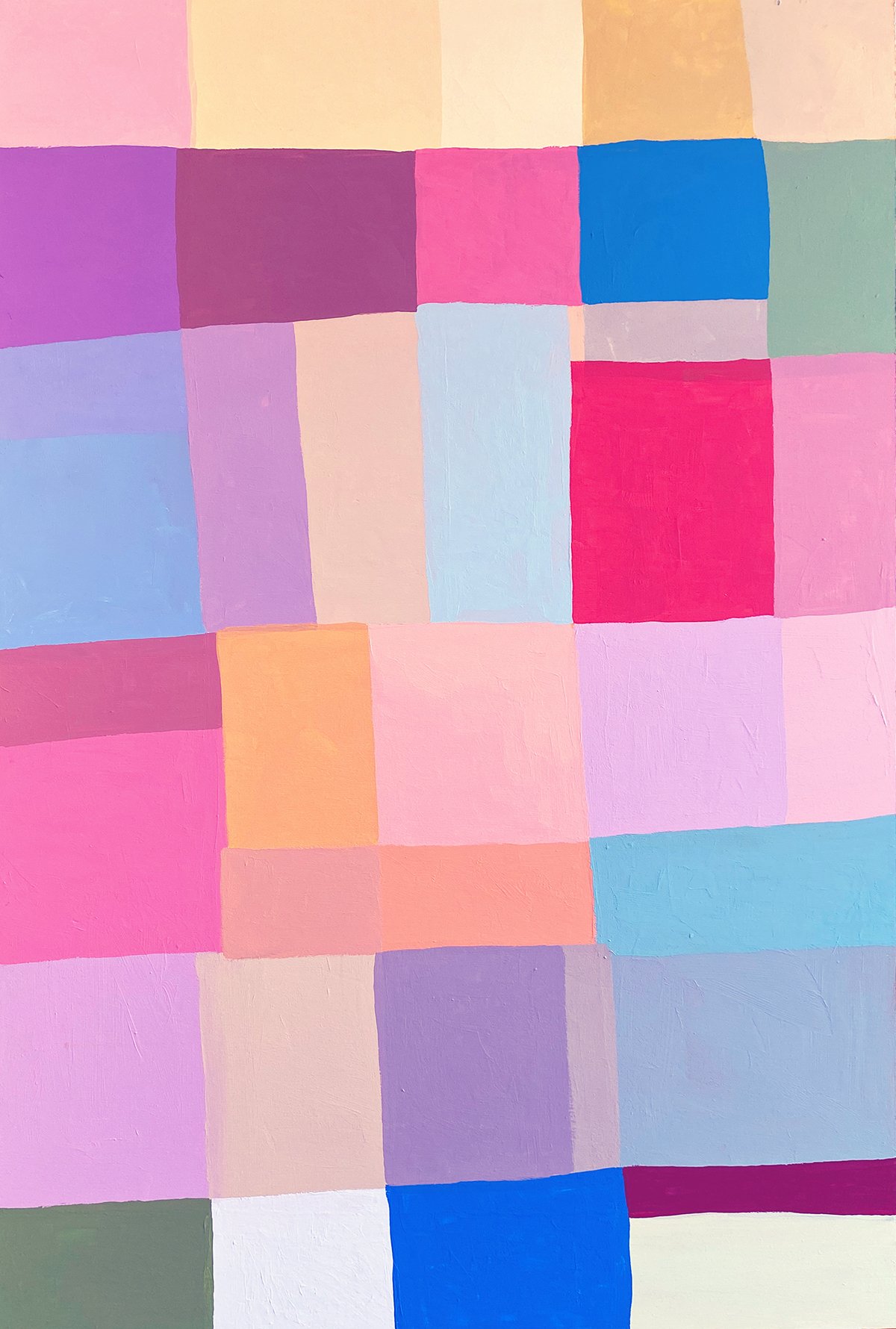
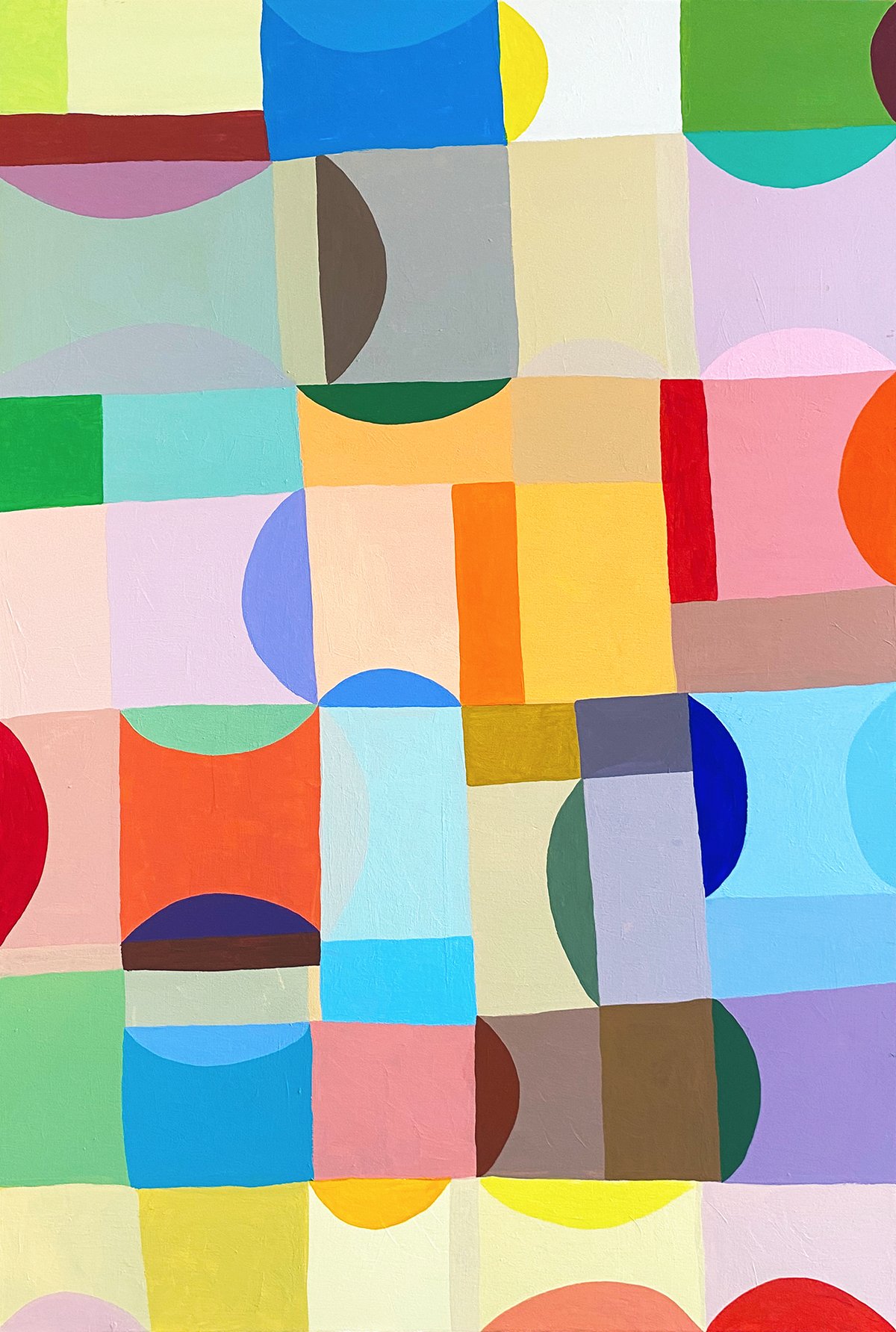
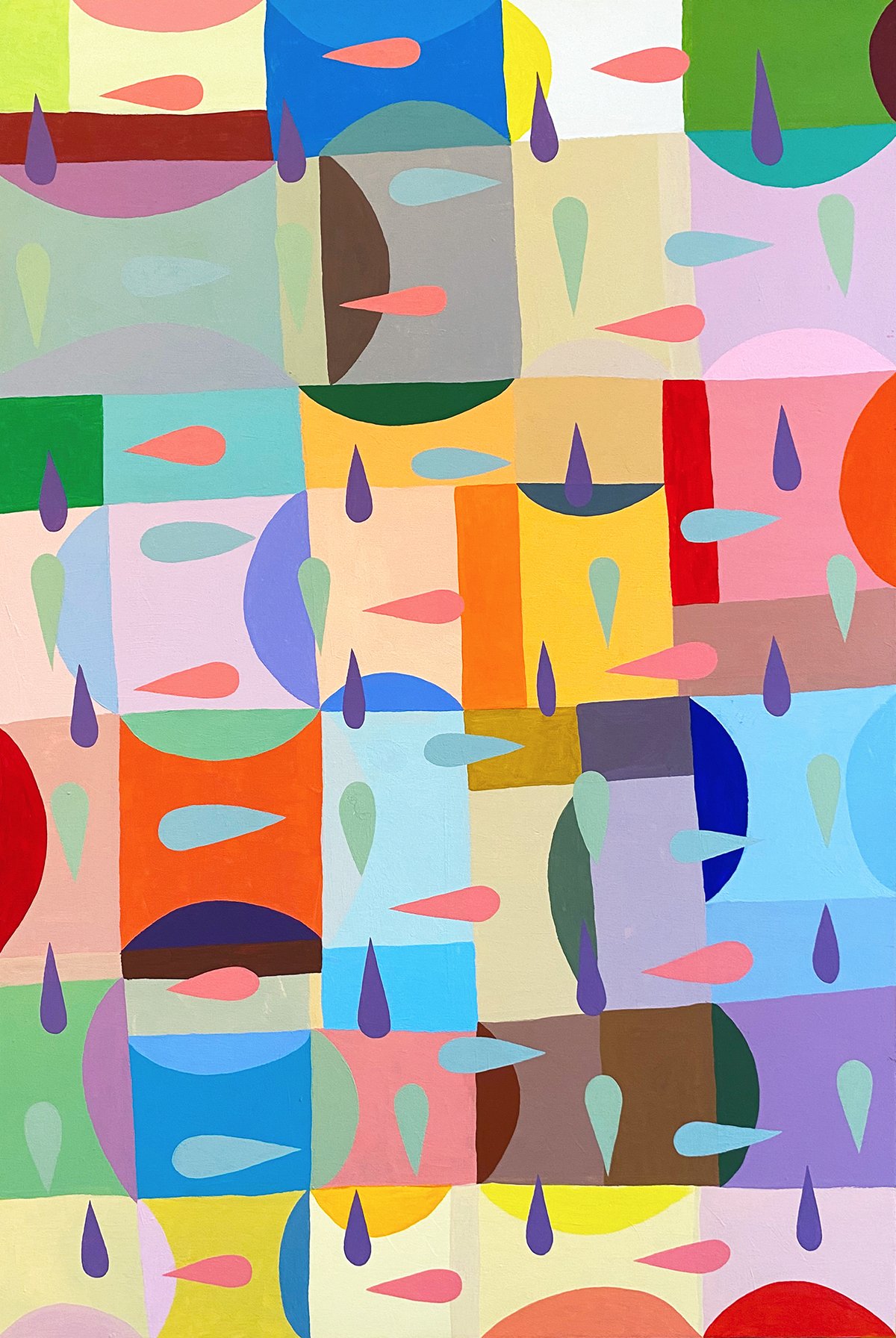
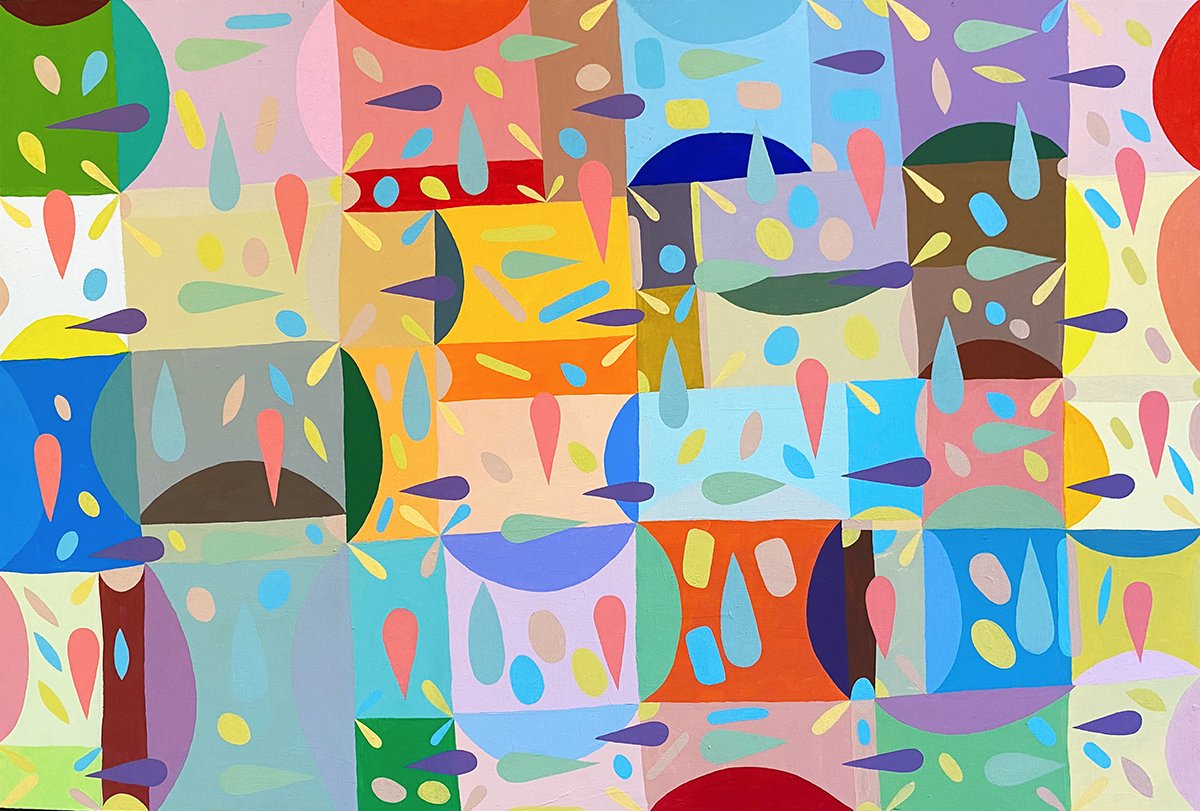
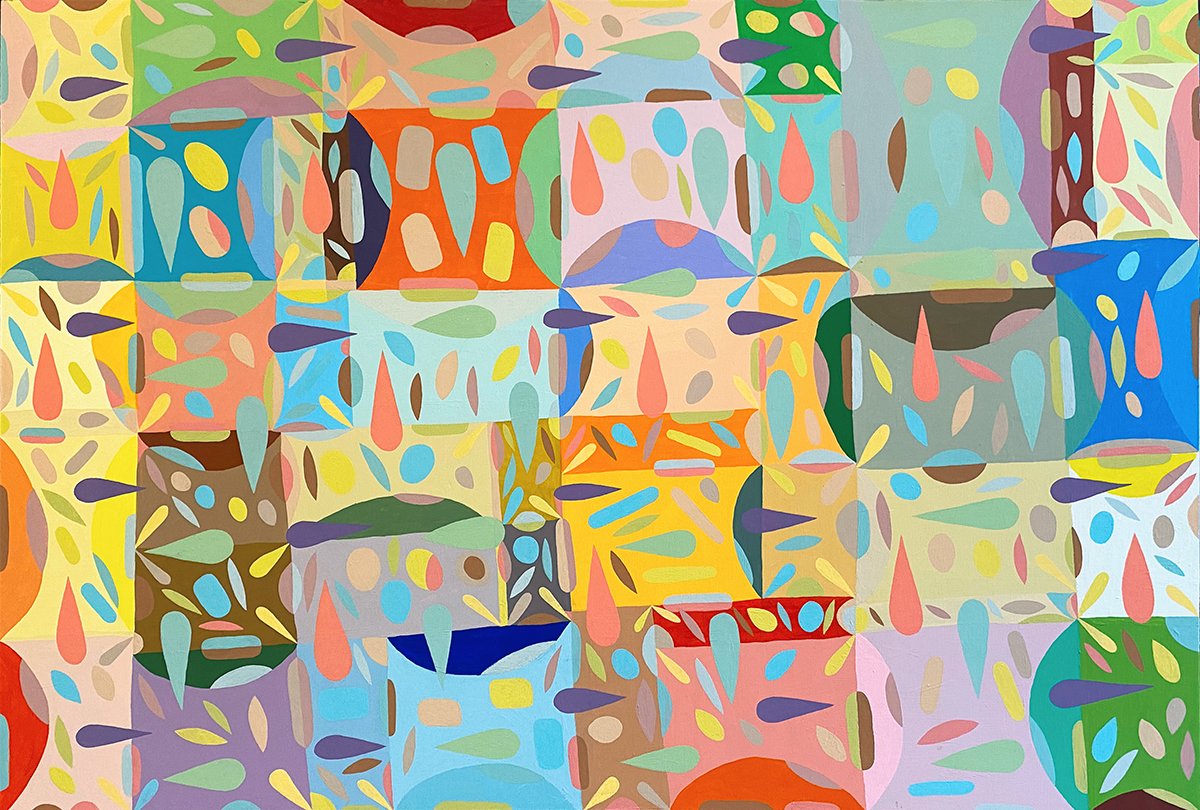
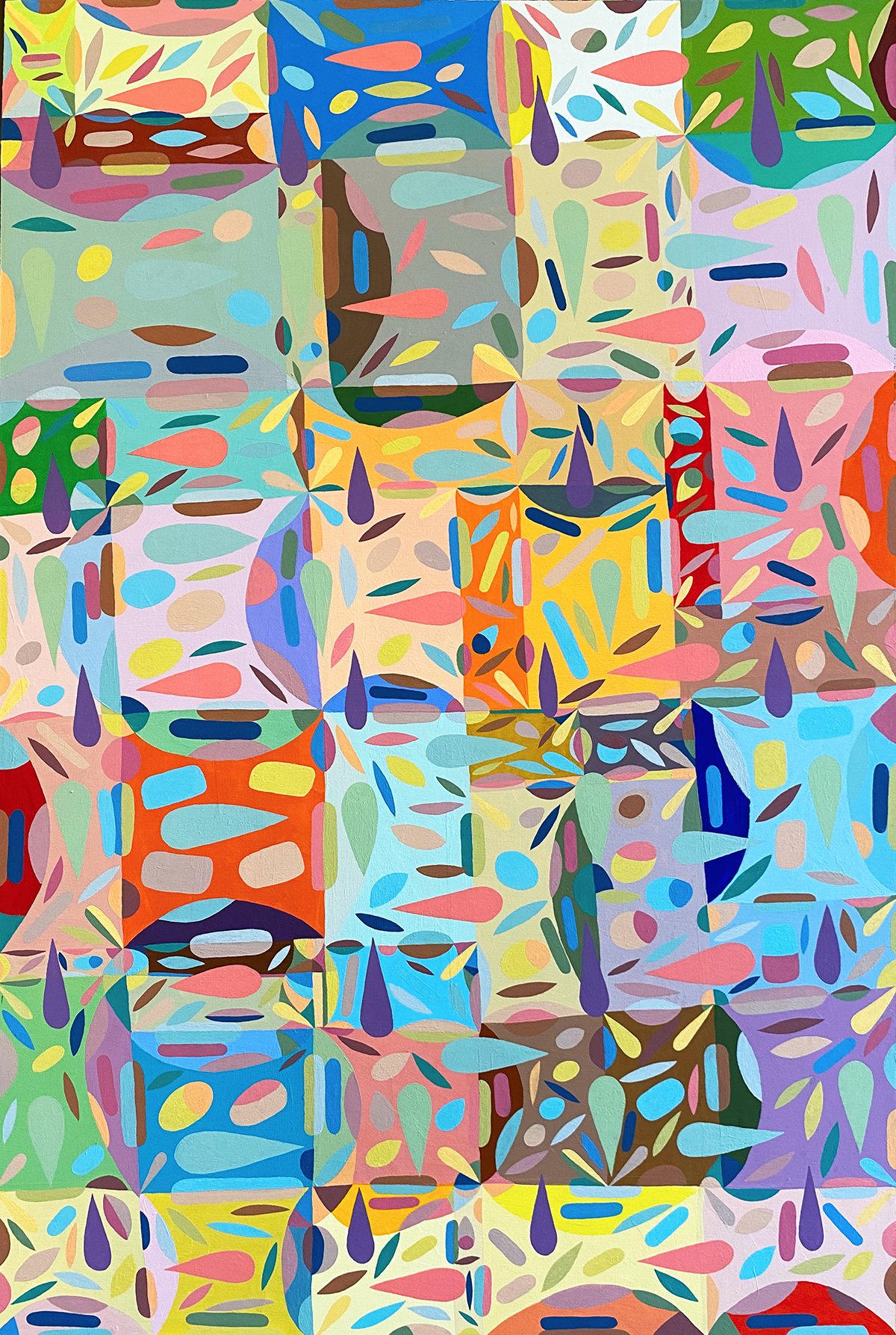
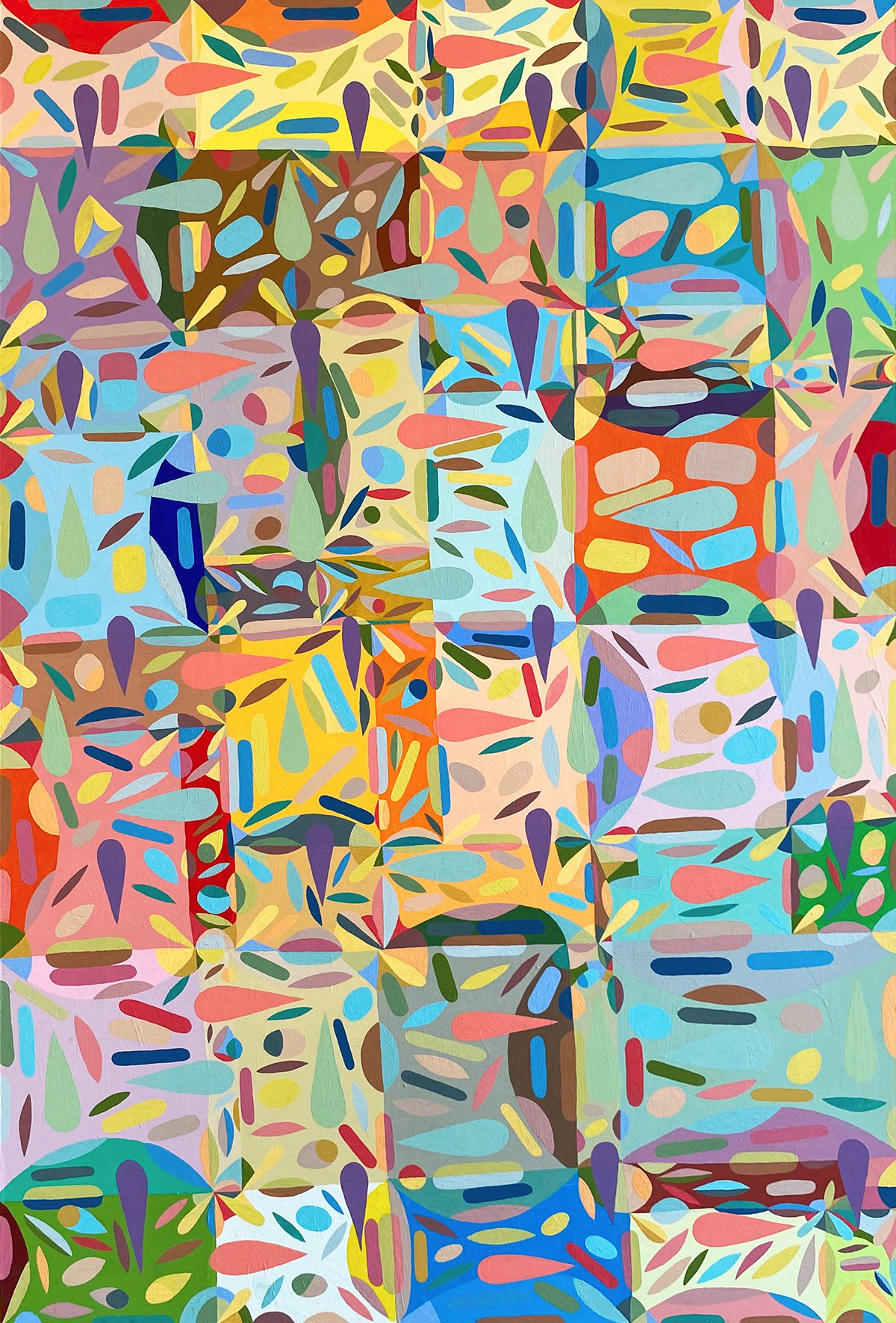
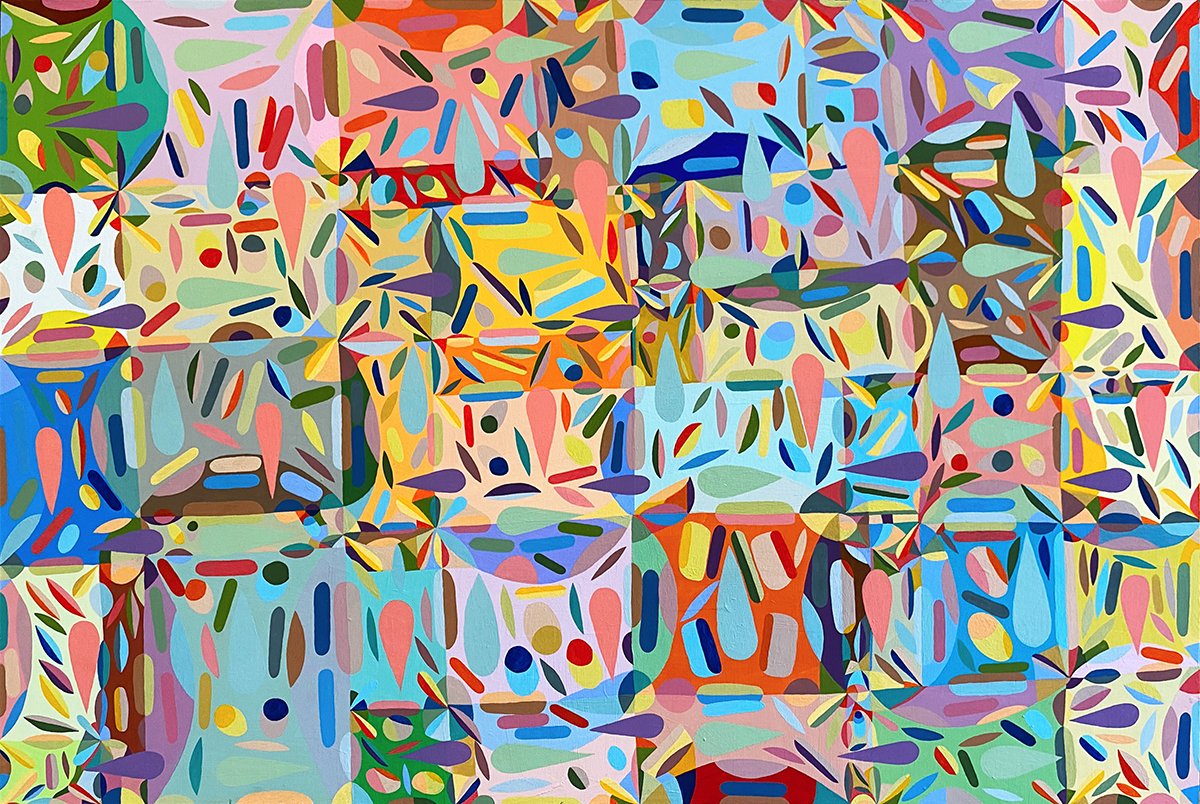
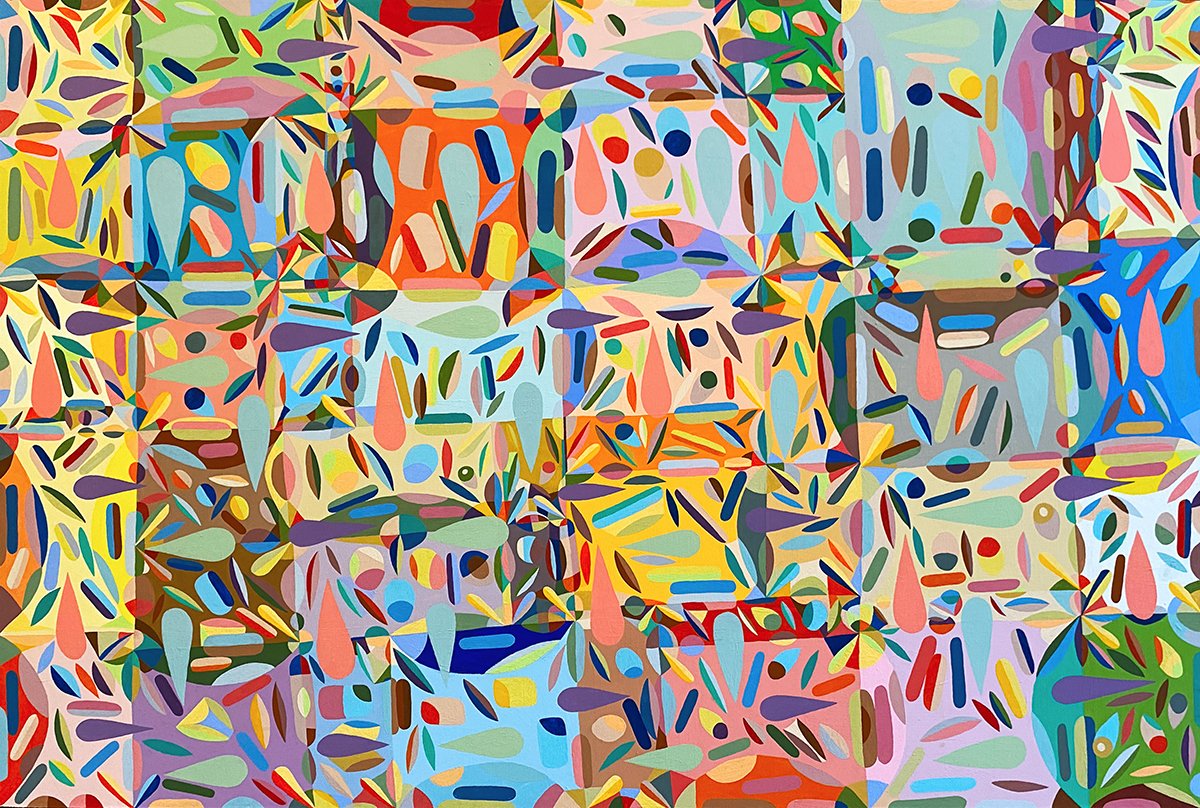
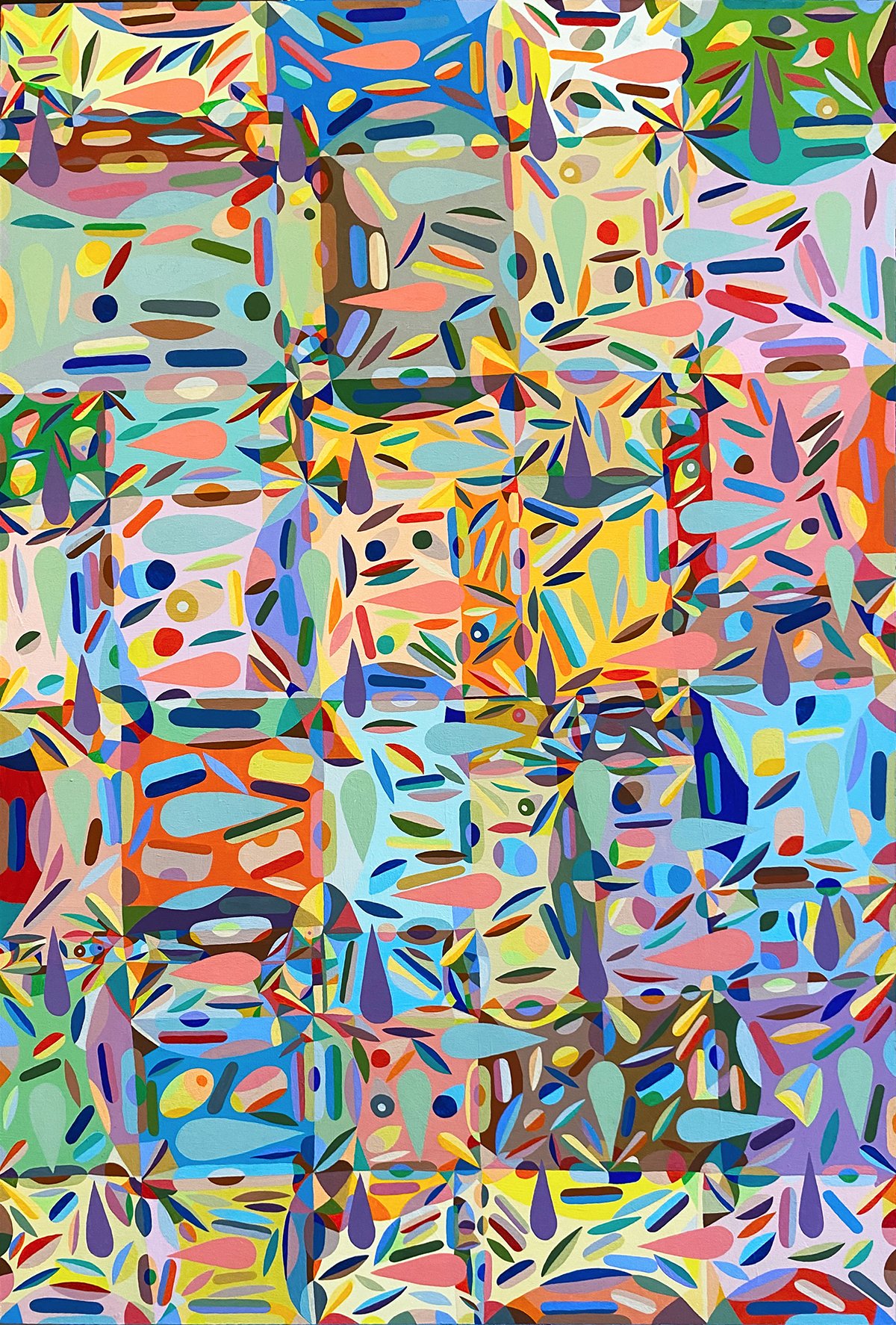
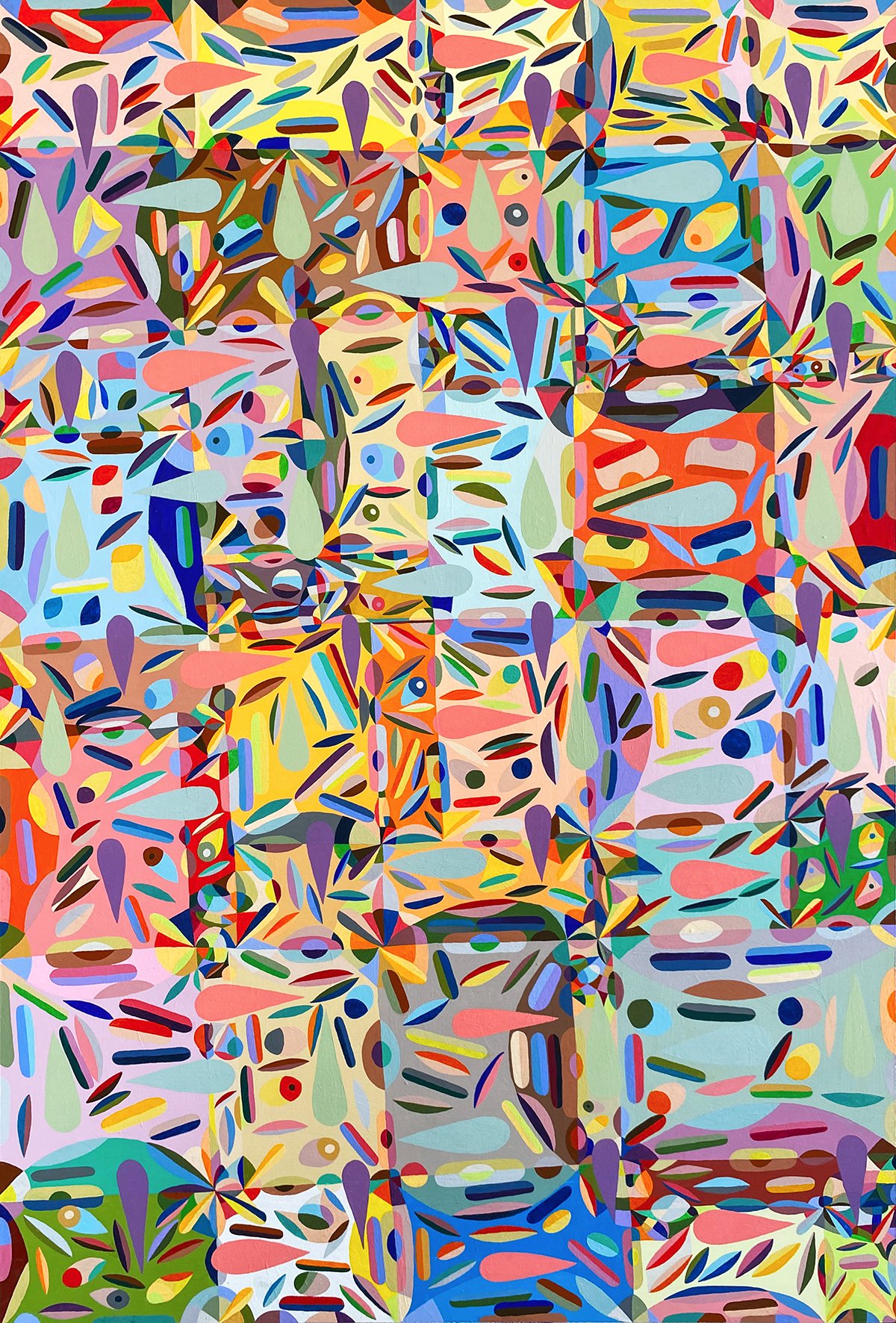
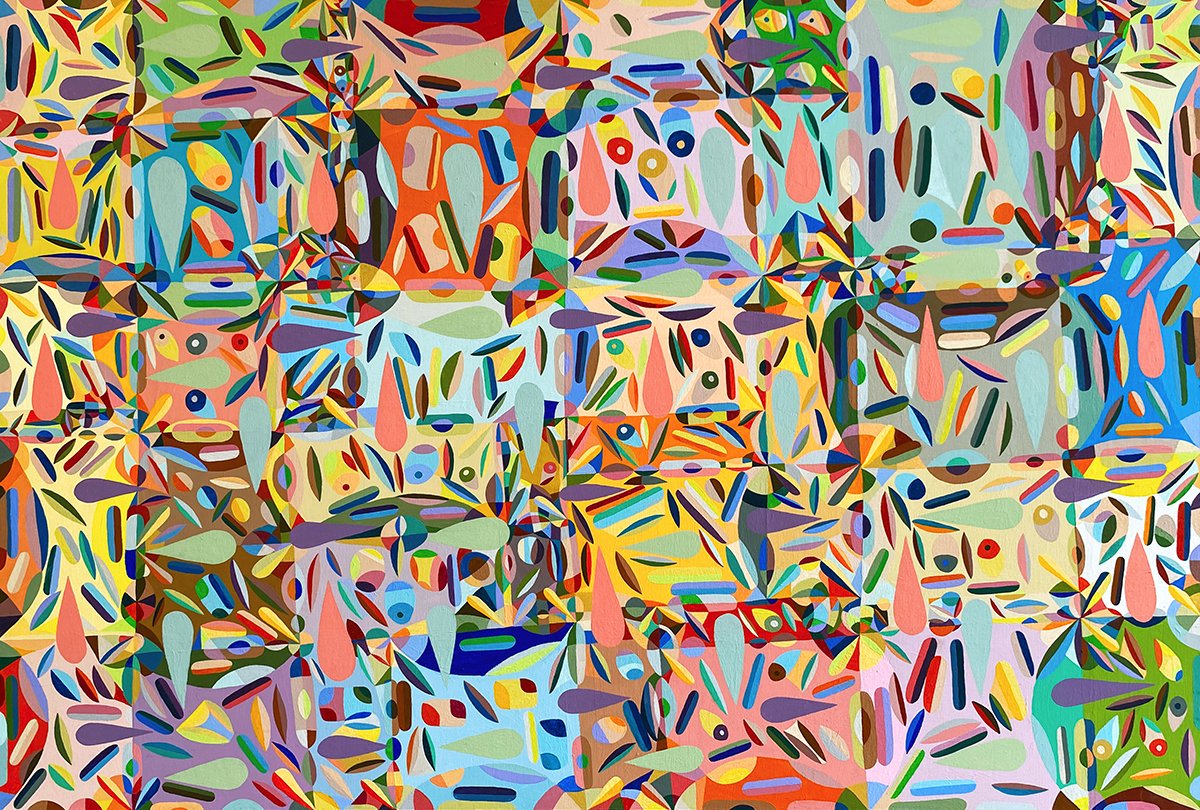
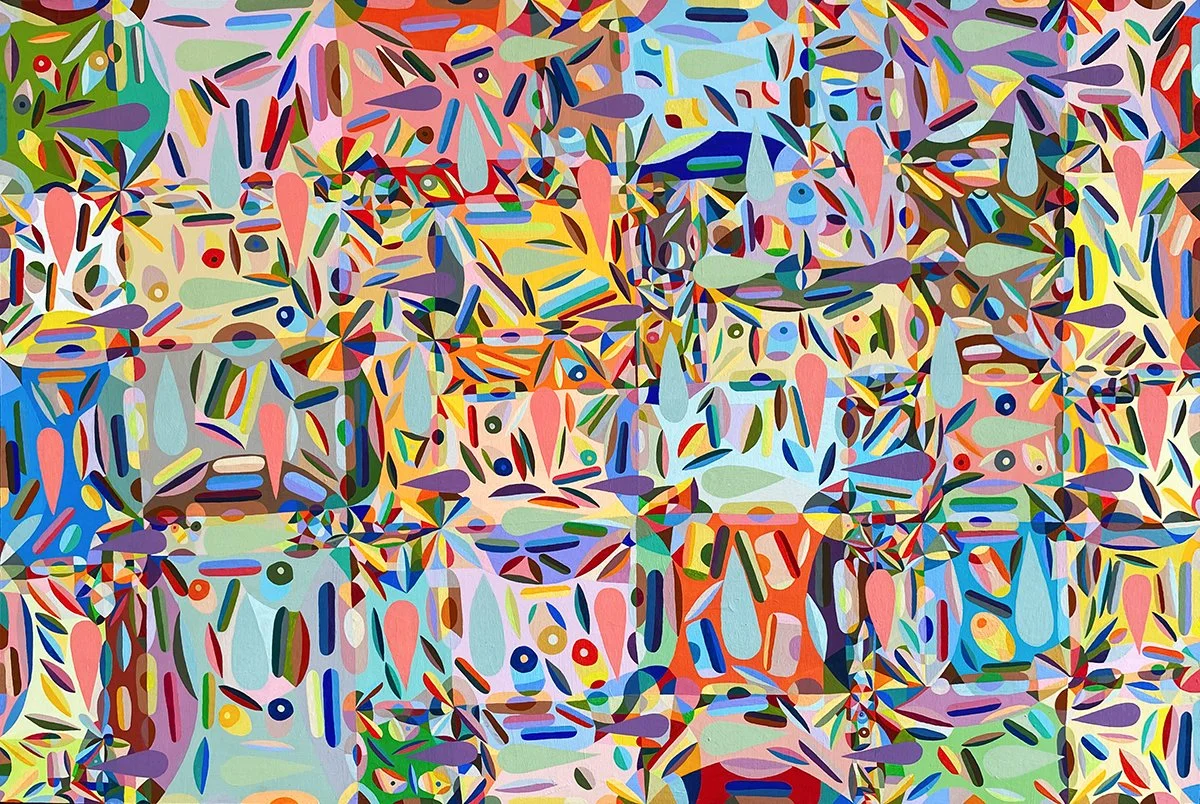
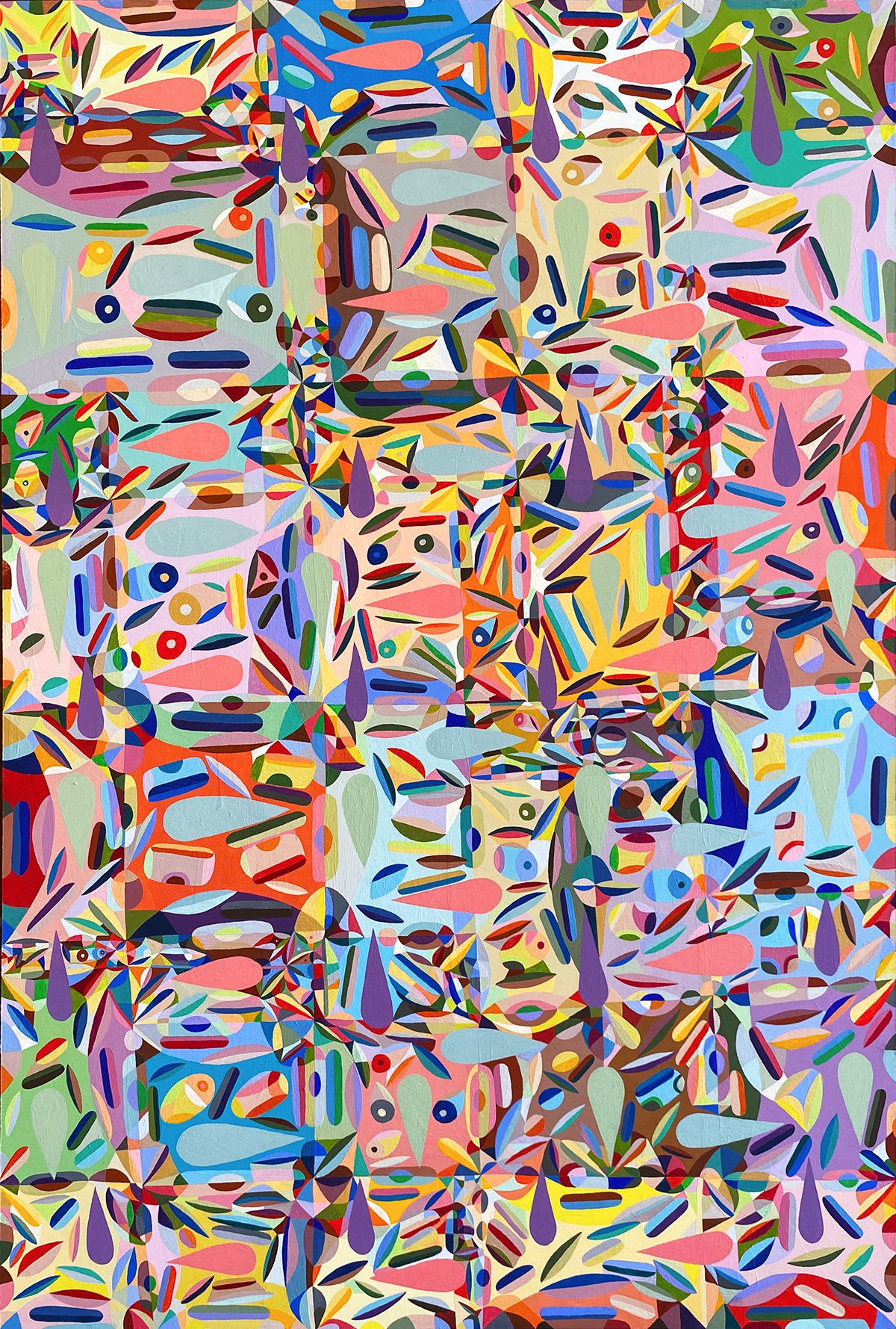
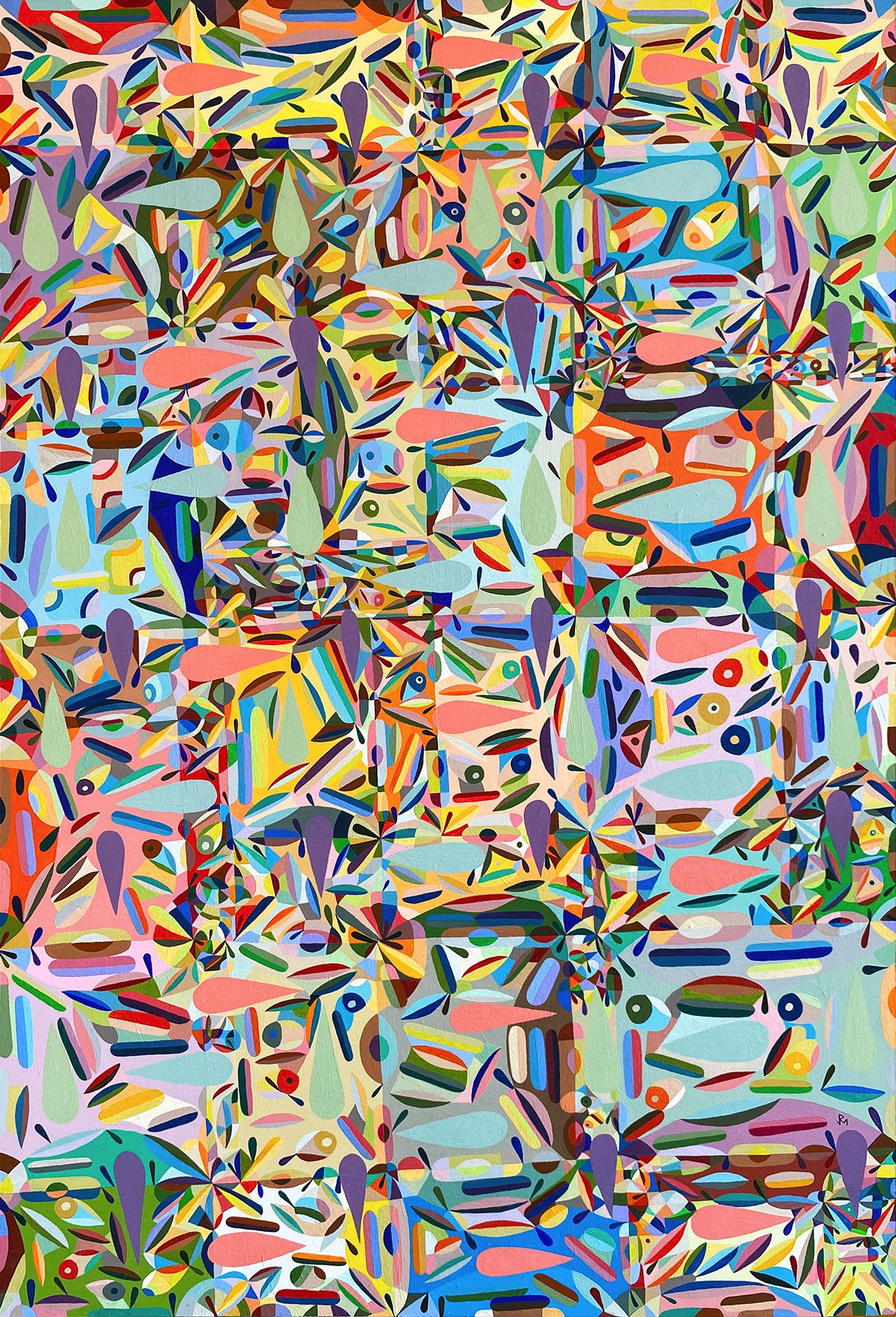
Witnessing and Creation
N-fusion Study #2, being the second of two studies, would be a dimensional expansion of the first iteration. The key subset to which N-fusion #2 belongs is the pre-sale/-commission series commenced in 2023. These artworks were programmatic, in that they were created in the studio, chronicled on and sold through Art for Humans (AFH) social media portals (Facebook and Instagram). Moving to Astoria, Oregon in 2018 meant dealing logistically with distance between us and the supporters of my work in New York, LA and elsewhere. I realized in the first year (2019) that the plans I had for setting up shop on the Northwest Coast were not viable. During and after the pandemic and socio-political polarization of 2019 or 2020 through 2022 my professional prospects appeared to be further diminished by shifts in the field. So, I launched a quite muted program of making small-scale paintings, and pre-selling them on the socials to my lists on the platforms. So far, this has proved a successful, if humble, strategy. N-fusion #2 is a much larger painting than the others in the subsidies, but it, too, sold, and in one of the most pleasant ways paintings can sell — to an old friend, an exchange that is serving to renew or refresh the relationship.
N-fusion Study #2 | 36” x 24” | Flashe Vinyl on Panel | 2023-4
Because N-fusion #2 had a priori a format, one might assume that the process of its execution would be functionary, facile or derivative, simply a matter of scaling up the design of N-fusion #1 by design. In dimensional painting, this is not the case. The enlargement of the paintable surface, and the divergence in ratio, entailed that the project in many of its aspects would require reorganization, the adaptation and adjustment of methods and applications. Scale is critical to such a maneuver, but there’s more to it. If one thinks of the vertical x horizontal planar surface of the painting as a field with dimensional aspects, one realizes that the painting will not only consist of 2D forms, but the embedded perspectival illusion of 3D volumes, as well. Further, push-pull configurations for spatial arrays of components must be considered. What I would call native 4d painting infers animation of internal elements in the framing edges of the geometric plane, whether it be rectangular, triangular, circular, or whatever. That is to say, the picture will provide the viewer with the sensation of movement, even though the actual painted image is static. In 4d, we must address space, time, depth and motion, even when the actual viewable surface of the painting is more or less flat.
The perceptual paradox is non-sensical in the literal description, but makes perfect sense in the viewing. The experience of the viewer depends on the scale of the painting, due to the interpretive expectations associating with the optical apparatus. Small paintings activate far-away vision, while big paintings activate the feelings of immersion. Middling paintings, like N-fusion #2, do something else. In an oblique way, I am disclosing the challenge I decided to take on by magnifying the formality of N-fusion #1 and translating it to the larger panel. I understood from the outset, based on practical experience, that the exercise would not be like an arithmetic or automatic operation, but an exponential one. Which turned out to be the case. I began N-fusion #2 in December 2023 and completed it in June 2024. The production timeline was about fourfold longer than those necessary to discharge the smaller studies. In my artist history, I never before exclusively devoted half a year to any single painting. For reference, between 1996-2005, I averaged an exhibition every six weeks to three months! During Art for Humans Gallery Chinatown (2007), we produced 26 exhibits and live art events in roughly ten weeks! N-fusion #2 required me to “level up,” in my easel painting practice. The affected areas in performance include concentration, discipline and patience. Which is funny (LoL), because the typical initial viewer response to the painting is not registering to craftsmanship as rigor. Expressed (initial) viewer reactions have been visceral, more attuned to the wild and boisterous concatenation of colors and shapes than the technical challenges in the making of N-fusion #2 (or #1 for that matter). The more time a viewer spends with the art, however, the more forthcoming are comments on the art’s evident degree of difficulty and technical depth or craftsmanship. I admit to being pleased by this viewer-art dynamic.
∞
In reviewing the painting documentation, and then uncoupling my catalog of memories from the fixed visual references, I discerned a liminal space separating the two. What to make of this — not exactly a disparity, but more like seeing a thing from different angles, or maybe a parallax effect? I surmise that an artist sees the painting, but that is only one facet of the creative act. Painting is a physical action, and throughout the painting of N-fusion #2, my body was wracked with arthritis. I am certain that fact compounded my short-term reflections on the painting’s production. Yet, my recollection of this pain is fading fast, to be displaced by critique, esoterica, and something along the lines of poetic reverie, even amazement. Beyond or post-posteriori these observations, another gaggle of factors and formulations drift into forefront. The blocky composition draws from previous incidences in my work, preceding VyNIL, as in HUM 10 + 1, but within the earlier stages of the VyNIL Cycle as well, as in the large Meta-Element paintings I showed last summer at Made In Astoria’s back room gallery. In N-fusion #2 I did something new.
HUM 10 + 1 show graphic/animated GIF
I introduced sphere fragments irregularly on the blocks’ edges. When I did so, I thought of animation cells. The combination brought to mind the landscape in relation to sun and moon, celestial bodies rising and setting on a plane or horizon line. The pinched ellipse shapes, evocative of teardrop or liquid iconography, hover over the sloppy grid. These shapes are painted in the same hues (from the same batches) used in N-fusion #1. I decided not to add an array of multi-colored ovoid forms, as I did in the first N-fusion study. The multi-colored bamboo-leaf like shapes that appear all over the composition structurally-speaking are bisected color combinations, pointing every which way. I won’t list all the other pre-figurative formal elements, but will outline a few of the primary ones: circles, biscuits (rounded-cornered rectangles), elongated pill-like shapes, many also bisected color combinations, although some of these became much more complicated as the painting progressed. N-fusion #2, by its completion, is not properly comprehended as a simple sum of all these parts, which is to me a critical point, or at least a clue about the method and painting.
The painterly experience for N-fusion #2 at times reminded me of solving a puzzle or a complex equation, and this has often been the case in the more complex VyNIL paintings. My Pattern series (Bushwick, circa 2015-6), exhibited in the “For Paris” memorial show at Dane and Samantha Rex’s Wild Hearts Salon is an important precursor. The methods I am using now are quite different from the Pattern works, in several significant ways. I won’t delineate these here, but to say that the VyNIL paintings are sequential, but less mechanical. Repetition is materialized according to an alternate visual rhyme and rhythm. The requisite focus and intensity at the easel is similar, but heightened, now. To frame the activity in labor terms, N-fusion #2 was a harder job in every respect, because it required a certain cerebral agility and commitment. I realize how vague or abstract this description might be for the reader, and I am probably doing poorly at precisely putting the observation into words. N-fusion #2 was created not by code, but by an inversion of the idea of code. For viewing, however, I think the effects of the two series (Pattern and VyNIL) on the viewer, especially the casual one, do have a resonant quality. Even though the execution of N-fusion #2 was demanding (on me, the artist), as alluded to above, the art itself does not convey this fact in any overt manner. I suspect that under the surface I am playing with the rules of the decorative, which is a container for the normative. On another note, during the painting of N-fusion #2, “contouring” was a recurrent imperative. Part of the technical difficulty has to do with the edging of forms in Flashe paints. The strain on eye and hand was a constant after the initial stages.
∞
The areas where the blocks intersected became phenomenal— at some point about halfway through the build-up of numbers of elements and colors. A good metaphor is the chain reaction. The first signs of this occurred when sphere fragments shared a line or corner. I came to think of the intersections as blooms, or rather the site where a bloom might arise, an area of energetic potential. Back-to-back, the sphere fragment combined to create double-pinched ellipses. My breaks from painting mostly involved sitting on our back porch, and taking in the impressive overgrowth of flowering bushes at the edge of the grassy areas. I think the backyard scene affected the painting’s structural and technical disposition, its energy. I also believe that the special light here in Astoria, where the Columbia River meets the Pacific, affects my use of color now. During N-fusion 2’s production, I was aware of these loose associations, but was mindful not to elevate them to the representational level. As less of the blocks’ base colors was visible, as the “foliage” multiplied, the prospects of naturalistic realism for N-fusion dissolved. If it seems I am tip-toeing around discourses on the Natural and Abstraction, I think that is a fair assessment. To which I would respond by saying the VyNIL has from the beginning been for harmonizing the Artificial or Virtual visionary with an Imaginary nature. It is also for the unconscious consciousness, which is not the same as Void or mechanical sentience or lack thereof.
By this I mean that the post-contemporary reality is suspect on all fronts, and rightly so, and multi-faceted or -dimensional. My paintings are meant to be experienced not just visually, or theoretically, which is to say, literally or contextually, as artistic content. I mean these paintings to be experience bodily, and this is also a domain of feeling, of sensation, the sensual. I do like these paintings in their overt evocation of the beautiful, as effulgent, ebullient Things. They are meant to be instances of happiness, joy and freedom. No matter what else might be happening in the world, and the art world. I think the above statements reveal much about my intention for the VyNIL Cycle, and in particular for N-fusion #2. I often wonder whether such an intention or motivation is too reactive, or a symptom of exhaustion, or an acknowledgement of one’s (and art’s) powerlessness in relation to the mundane and banal unfolding of catastrophe and cataclysm common in the post-contemporary period. My answer is spiritual, not secular, and not psychological, and many other nots. After all, catastrophe and cataclysm are not novel to humanity, which is not to say, we do not experience rupture and fracture anew in each horrifying episode of obliteration and chaos. The spiritual mode of existence is not outside destruction and its obverse or converse, the Creative. Spirituality, broadly measured, is an embrace of both, either- and or-.
I do understand or situate my practice of art in a spiritual framework. Which I believe obliquely my regard for the referential as fuel for my art-making. Which indicates why I might suggest that Angelicism01 and Film01, and the New Models and Joshua Citarella podcasts provide the proper post-contemporary context for N-fusion #2. They are not symbiotic or co-dependent entities. Rather, we share the same atmosphere, or the same hemisphere, or the same social sphere and creative/destructive spiral. My playlist included Radiohead and The Smile, but also Chopin’s Nocturnes. The post-contemporary must address time and its ending, from a directional point of view. This small sample of background audio in the studio wouldn’t denote “the Spiritual” to anyone but me, and so be it. The studio soundtrack is a seam coursing through decades of artist life, and I have shared my preferences and likes/dislikes, favorites and so on elsewhere. My point is, talking about the Spiritual and Art, opens the text to influences and inspiration, and we all understand this. To discuss art and not spirit is to leave the unspeakable to its own devices.
Instagram post at the official Angelicism01/Film01 portal.
I could and would add much more disclosure here of a biographical sort, and share circumstantial information about what was happening in my life and the lives of those close to me while N-fusion #2 was coming into being. Pardon me if I save those confessions for another time, place and project. Anyway, I am not sure how valuable any such disclosure is to the art post-facto. I could also insert a chronicle of the course of historical events unfolding between December 2023 and June 2024, but if you are reading this, you were there yourself, or have access to the archives. And I would argue that my position on personal confession and art post-facto holds true with respect to the historical and art post-facto. Up to a point. of course. The point is, whatever might have been going on out there, beyond the four walls of my little AFH (home) Studio/Astoria, where N-fusion Study #2 was started completed, what was happening spiritually for and within its maker is as important, and perhaps more important, than anything else. The question, naturally, is where do in here and out there start and stop? It seems clear that the border between the two is blurry at best, and permeable. Is this also as true for art, the Thing, as it is for us humans?
With that speculative declaration posed ultimately as a query (and not set in stone), I wanted to discuss the completion phase of N-fusion #2. Toward the finish, I would often enter the studio already worn out, to some degree, not just by the painting, but by other life-y matters. Yet, day after day, session after session, I was sure there was another level that had to be done, achieved or reached, something dimensional, but I wasn’t certain what that was. A painter will know the feeling, and it can be one of the worst we contend with, a sort of grim despair at resolution out of one’s reach and falling or fading away. One must be mindful not to burst or crack, and attack the painting or strike at it destructively out of exasperation. In the extreme, this overreaction is not hyperbole. We have too many art historical examples to wave off the danger. Anyway, I introduced the little “leafy” forms (ellipses pinched on one-end, like the “teardrop” shapes), which are visible other paintings in the series. I think of these as signs of “growing things,” and I mostly used the “darker” colors in the Flashe palette directly from the jar. It worked! And just like that the solution necessary to reach the finish of N-fusion had arrived. The remaining sessions were essentially mapped out, concluding with the signature.
The end, just before the signing, is one of the best moments. I search the painting for anything left to be done. If I find nothing, it is time to tattoo the art, to brand it with my runic PJM. This process of finalization can span a day or two. I might sleep on it, and sign in the morning after dawn. I might wait until I have afternoon light, which in this Astoria studio is just lovely. I think it is true to say that nothing about a painting is more wonderful to me than finishing it. I love the other bits dearly: the anticipation and commencement of the work; its presentation and exhibition upon completion; the documenting and selling; the conversations — all of it! But none of it is sweeter than those last strokes of the brush, and I couldn’t really explain that, more than saying it is a sense of fulfillment unlike anything else. I doubt it is the same for all painters. I have spoken with many artists who feel like their paintings are never quite finished, that there is always more to be done. I am very grateful that is not my experience.
N-fusion Study #2 | 20” x 16” | Flashe Vinyl on Panel | 2023-4









